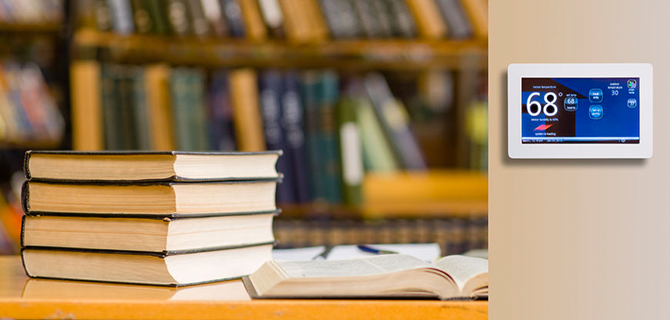Sensors convert chemical information into an electrical signal that we can capture and analyze. But how can this technology be put to use in a traditional library? Radio-frequency identification (RFID) is a sensor type that has found its way into many libraries for tagging assets, checking material in and out, general shelf management, and security. […]

Sensors convert chemical information into an electrical signal that we can capture and analyze. But how can this technology be put to use in a traditional library? Radio-frequency identification (RFID) is a sensor type that has found its way into many libraries for tagging assets, checking material in and out, general shelf management, and security. This technology means that inventories can be taken without removing books from the shelf.[1] However, biosensors may offer an even greater potential for librarians.
Biosensors can convert analog chemical information into a digital signal, allowing computers to monitor and adjust systems without human input. The sensors are made by linking a transducer with a recognition element and are increasingly being developed on a nanoscale.[2],[3] ACS Axial previously covered some of the biomedical uses of sensors, but there are also environmental applications. Low-power, wireless sensor networks could be invaluable in traditional libraries to monitor special collections, as well as to track the usage and movement of materials.
Protection for Sensitive Materials
Paper is an organic material, and with age, the components are broken down by acid hydrolysis, giving off volatile and semi-volatile organic compounds (VOCs) into the air. This is the basis of the familiar scent of old books – a mix of vanilla (vanillin), almond (benzaldehyde) and musky florals (ethyls, toluene, and hexanol).[4],[5] Control of temperature and humidity within a library is key since excessive heat and humidity can accelerate decay.[6]
Libraries need systems for maintaining temperature and humidity within a recommended range every day of the year. These systems need to be able to respond quickly to fluctuations. General control of air quality is also needed since contaminants such as sulfur dioxide, peroxides, and ozone can set off chemical reactions leading to acid damage on old paper or leather. A network of biosensors capable of reading changes in the air could deliver up-to-the-minute real-time data and allow necessary adjustments to be made, helping to preserve resources for longer.
Evolving Knowledge of Biosensors
Recent research suggests that a printed array of polydiacetylenes could be actively employed in chemosensor systems using a conventional smartphone to identify VOC gases with 100% accuracy,[7] which could provide an ideal and low-cost way to monitor the decay of collections. In addition, a similar optoelectronic ‘nose’ has been used to monitor valuable artworks in sealed display cases.[8] These ‘e-noses’ rely on an array of semi-selective and reversible gas sensors combined with pattern recognition software, which allows them to mimic a human olfactory system.[9] The potential of using nanowires for VOC sensors is also being investigated.[10]
ACS Sensors was launched in 2016 to disseminate new and original knowledge on all aspects of sensor science that selectively sense chemical or biological species or processes. ACS Axial continues to monitor the field for librarians.
[1] Library RFID system. Available at: http://www.rfid-library.com/ (accessed March 2018).
[2] Soleymani & Li. Mechanistic Challenges and Advantages of Biosensor Miniaturization into the Nanoscale. ACS Sens 2017;2(4):458–467.
[3] Zhang et al. Nanochannels Photoelectrochemical Biosensor. Anal Chem 2018;90(3):2341–2347.
[4] Schmidt. On the smell of old books. Anal Chem 2009;81:8656.
[5] Strlic et al. Material Degradomics: On the Smell of Old Books. Anal Chem 2009;81:8617–8622.
[6] Northeast Document Conservation Center. Available at: https://www.nedcc.org/free-resources/preservation-leaflets/2.-the-environment/2.1-temperature,-relative-humidity,-light,-and-air-quality-basic-guidelines-for-preservation (accessed March 2018).
[7] Park et al. Smartphone-Based VOC Sensor Using Colorimetric Polydiacetylenes. ACS Appl Mater Interfaces 2018;10(5):5014–5021.
[8] Artificial ‘nose’ sniffs out pollution to protect Disney art on international tour. Available at: https://www.acs.org/content/acs/en/pressroom/newsreleases/2016/march/disney-art.html?_ga=2.194217064.476949687.1521462066-697058457.1516626201 (accessed March 2018).
[9] Sekhar et al. Chemical Sensors for Environmental Monitoring and Homeland Security. Available at: https://www.electrochem.org/dl/interface/wtr/wtr10/wtr10_p035-040.pdf (accessed March 2018).
[10] Mahapatra et al. Electrostatic Selectivity of Volatile Organic Compounds Using Electrostatically Formed Nanowire Sensor. ACS Sens doi: 10.1021/acssensors.8b00044.
